Ventilation of the roof ridge: types + installation manual for ridge strips and aerators
When planning work on installing a pitched roof, you most likely wondered why ventilation of the roof ridge is necessary. Surely they decided how to make it better. We found out whether the arrangement technology depends on the type of roofing.
Only properly arranged ventilation in the area of the ridge ridge will ensure complete drainage of the roofing cake. Formed by her air currents will remove the vapor from the insulation, preserving the height of its insulating qualities. Blowing will prevent condensation on the wooden elements and their destruction.
In the article we will talk about what options for ventilation of the ridge exist. We will introduce the solutions offered by manufacturers, give examples of self-fabrication of structures.
The content of the article:
What functions does the ridge ventilation perform?
The ridge is a horizontal element connecting two roof slopes in their upper part. Despite the apparent simplicity, in order to ensure a long service life of the roof, this element must perform two functions at once:
- Prevent penetration of rainfall, insects and birds into the roof structure;
- Allow steam and humid air to freely exit from under the roof into the street.
If the task of protecting the roof from precipitation and foreign objects is obvious, and most developers fulfill it, then many manage to forget about the ventilation of the ridge.
Ignoring the requirement for ventilation of the ridge can lead to the most serious consequences, up to the need for a complete reconstruction of the roof.
The fact is that even with a well-made vapor barrier of insulated ramps or attic flooring from the house, a little, but continuously warm air and steam get into the roof space. Then warm air and steam rise up to the roof arch, which is covered with a ridge.
If, having reached the ridge, this air will meet an obstacle and will not be able to go outside, then it will cool down and begin to collect in large drops. Water in thermal insulation halves its ability to interfere with heat waves. Puddles on the floor will at least turn into a favorable environment for mold and other putrefactive microorganisms.
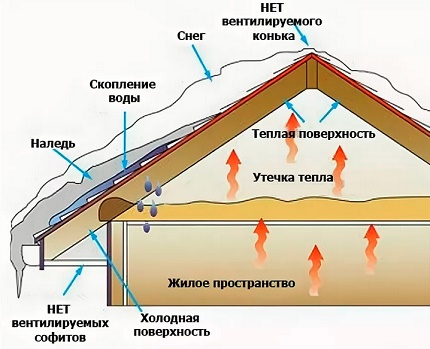
This process will be repeated endlessly, and will lead to excessive humidity in the roofing system and in the limited roof space, wetting of its wooden structures and insulation.
The inevitable consequences of working in this mode is the defeat of wooden structures with blue rot and black mold, metal fasteners - rye. The result will be loss of bearing capacity and subsequent destruction.
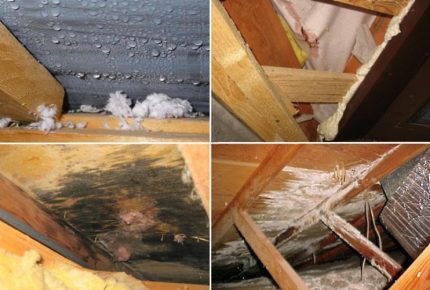
In order to prevent this scenario, the skate must necessarily provide free ventilation. To do this, there must be holes in it through which air from the under-roof space will be removed to the street.
If good roof ventilation is provided for the roof, then the situation is completely different.
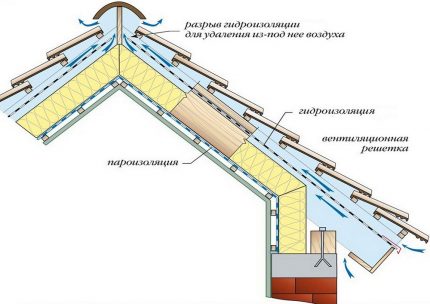
Streams of warm air, which in various ways got into the under-roof space, rise to the very top to the ridge and without encountering resistance on their way freely go outside, taking with them excess moisture. Thus, a comfortable mode is provided for the roof, and the risk of wetting the insulation and infection of the wood with the fungus is minimized.
Preparing to install a ventilated ridge
There are several options for a ventilated ridge device, which will be described below. But in order for any of these methods to work, even at the stage of installation of roof slopes, two important conditions must be met.
Firstly, regardless of what material the roof is made of, to ensure ridge ventilation, a gap should be left between slopes with a width of 5-10 cm. This space is necessary for the free benefit of air from the under-roof space to the ridge and ventilation holes.
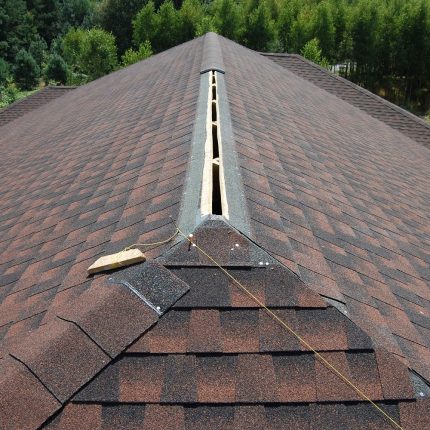
Secondly, if you used a waterproofing film when installing the roof, then in the area of the ridge this membrane should also have a longitudinal gap of 5-10 cm in width. When using a waterproofing membrane, it is not necessary to leave this gap, because this material is able to pass moisture out through the pores.
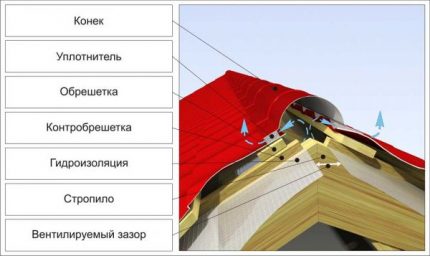
The fulfillment of these two rules is an indispensable condition for the operation of ridge ventilation.
Options for the manufacture of ridge ventilation
Roofing materials abound in variety.Each of them, whether it is metal, ceramic or soft tiles, decking, slate or ondulin, has its own characteristics. Roof structures assembled for different materials differ from each other. Therefore, the design of the skates and the ways of organizing their ventilation also vary.
Depending on the roofing material and the personal preferences of the builder, three types of ventilation are usually used:
- Ventilated ridge on the roofs of corrugated materials;
- Ventilated ridge on the roof of soft tiles;
- Skate ventilation with universal aerators with conventional or pipe deflectors.
All of these ventilation methods work effectively. And even amateurs can perform any kind of ridge ventilation.
Installation of the ridge on corrugated roofs
This method of ridge ventilation is the simplest and cheapest.
The fact is that roofs made of metal, metal and ceramic tiles, slate and ondulin have a wavy shape. Due to this, gaps are formed between the roofing material and the plank of the ridge, through which air can freely exit from under the roof.
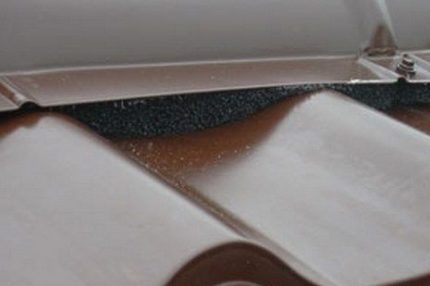
Therefore, for a roof made of such materials, the installation of a ventilation ridge can be performed in just two stages:
- install a seal or a special ridge tape;
- fix the skate strip over the sealant.
The sealant and tape do not allow snow, dry leaves, insects or birds to get under the roof. This is especially true if the roof is flat, that is, has a small angle or is located in an area with frequent winds.
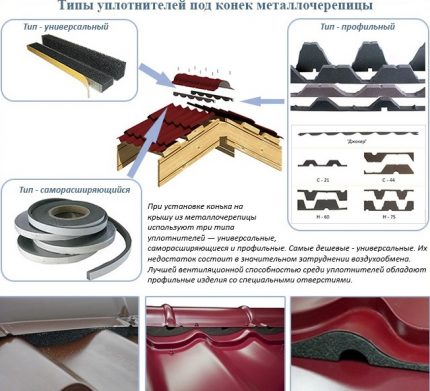
Structurally, the tape and seal are strips of porous materials that pass air well but retain small objects. For strong fastening and elimination of cracks, the sealant and tape have an adhesive layer.
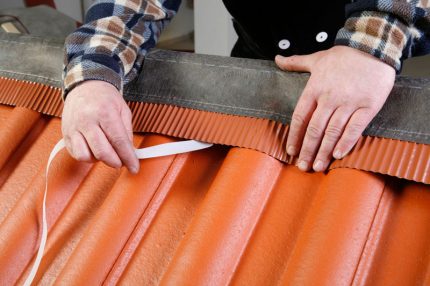
It should be noted that sealing roofing tapes began to be used in domestic individual construction relatively recently. However, their installation is not a prerequisite. However, they perfectly protect the subroofing space from dust, and at the same time they do not affect the speed and volume of the outgoing flows through them.
In the case when the gap between the slopes with a large margin is overlapped by a wide ridge plank, the probability of falling under the ridge of rain or snow and without seals is practically absent.
With all the subtleties of a roof ventilation device with a metal-roofing, it will introduce next article, which we recommend reading to the owners of cottages and suburban estates.
Mounting the ridge on flexible tiles
The roof made of flexible tiles is absolutely flat, therefore, if the ridge elements are simply fixed on it, then there will be no ventilation gaps, like on corrugated roofs.
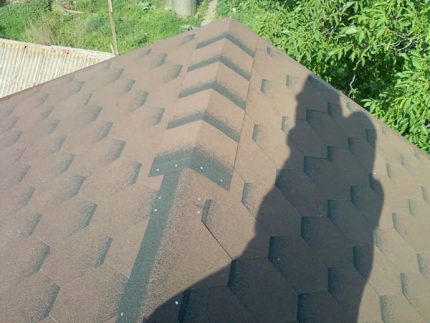
If the gap that is left between the slopes for ventilation is hermetically sealed with the ridge tiles of the flexible tile, ventilation outlets are selected at the top of the pediment.Most often, these are small holes above the girder roof girders or the pediment windows located below.
For the manufacture of a ventilated ridge on the roof of a flexible tile, it is necessary to install an aeration structure that forms a longitudinal gap between the plane of the ramp and the ridge.
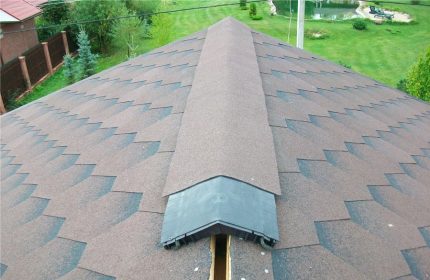
There are two options for constructing a ventilated ridge structure:
- Installation on a skate factory aerator;
- Making a ventilated ridge with your own hands.
Both methods are simple and guarantee an excellent appearance of the roof with an equipped and beautifully designed roof. Installing a ridge aerator is a great way to save time on installation work and by default will provide protection against foreign objects getting under the roof.
In the construction market, there are many options for ridge aerators from various manufacturers. However, the principle of their device is similar: the aerator is a plastic structure that creates a gap for the exit of air. From the side of the street, the aerator is equipped with a mesh that prevents insects and birds from getting inside.
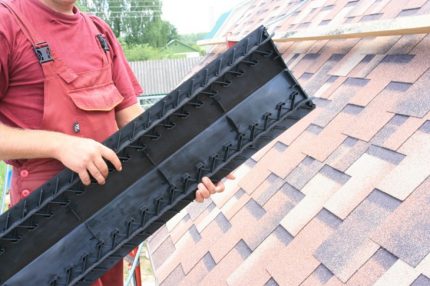
Depending on the needs of the builder, the ridge aerators provide a different level of protection against the penetration of foreign objects and rainfall under the roof. The smaller the cells in the grid or grate of the aerator, the smaller the size of the particles they let through.
In addition to coarse wire meshes, some aerators also have sealing tapes, which completely exclude the possibility of falling under the roof of something.
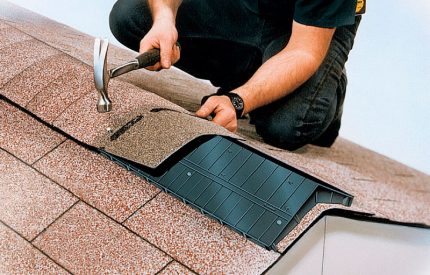
The installation of such a ridge aerator does not cause difficulties and occurs in three stages:
- Before laying flexible tiles along the ridge line reinforce the crate. Usually a board is used here if all slopes are equipped with OSB boards. If the crate was made by the board, then along the ridge ridge it is placed without gaps. A waterproofing carpet is laid on top.
- The skate on nails or screws is fixed to the board laid along the slopes;
- Tiles are mounted on top of the ridge in the usual way.
The factory-made skate has a long service life and guarantees good ventilation.
You can also make a ventilated ridge with your own hands, if for some reason you do not want to use a factory-made ridge aerator.
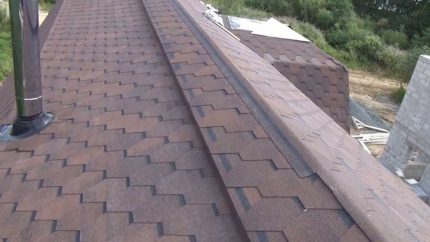
For the independent manufacture of a ventilated ridge, the same materials that were used in the construction of the roof itself will be required:
- Laths from a bar 50 × 50 mm;
- OSB or plywood;
- Flexible tile designed for equipping a ridge. It can be bought in a ready-to-install form or cut independently from ordinary shingles;
- Galvanized roofing nails.
If desired, to protect from snow, insects and birds, you must purchase a cornice or some other mesh.
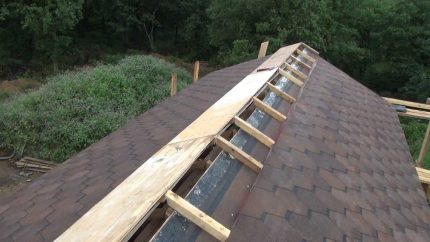
First of all, we fix the lattices in the upper part of the slopes above the rafters. The length of the bar depends on the angle of the roof: the smaller the angle, the longer the elements of the crate should be made to prevent rain from entering the weather. In normal cases, a length of 50 cm will be sufficient.Excessive increase in the length of the crate and ridge elements will hinder air circulation.
To the ends of the bar we fasten the cornice grid of the appropriate height.
Next, on the whetstone we install the base under the flexible tile from OSB or plywood, on top of which we fix the flexible tile in the usual way.
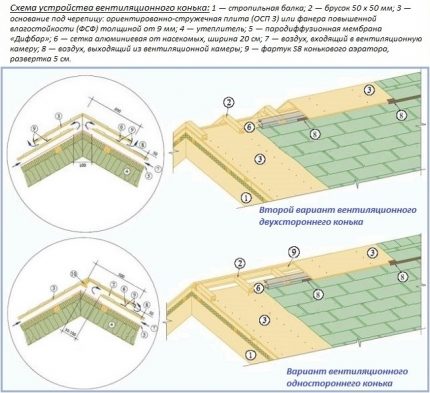
The ridge ventilation made in this way will harmoniously repeat the appearance of the roof and will not require serious skills and financial costs.
Installation of ridge aerators
There are situations when the ventilated ridge cannot be installed. For example, on roofs with a small angle of inclination, the snow cap does not come off and can block the ridge, completely stopping ventilation. In areas with snow and strong winds, a ventilated ridge can blow snow.
Also, during operation, it may turn out that the ventilated ridge is not effective enough. In these cases, the best option is to install deflectors on the skate of universal aerators.
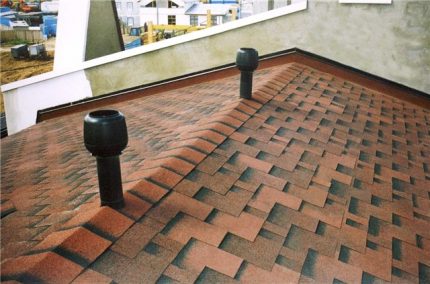
The roof aerator can be installed in any type of ridge element. It can be used as the main element of ridge ventilation (with a deaf ridge), as well as in addition to the existing ridge ventilation.
The advantages of this solution are:
- Excluded from the roof are precipitation and other foreign objects;
- The ability to apply on roofs with a slight slope, on which snow accumulates;
- Providing extra traction.
Unlike the ridge aerator, which discharges air evenly over the entire length of the ridge, the ramp aerator provides point ventilation. Therefore, when using it, it is necessary to ensure that there are no obstacles to the movement of air towards it along the ridge. This can be done by cutting the top of the rafters 5-7 cm parallel to the ground.
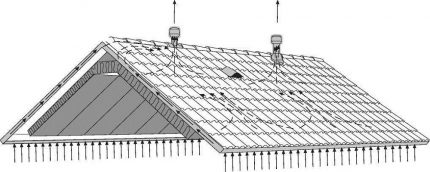
Manufacturers offer an excellent selection of ridge aerators, as well as ventilation pipes with turbine or conventional ventilation baffles. They are suitable for any type of roofing, so choosing the right device for you is not difficult.
Consequences of weak or zero ventilation
Concluding the topic, one cannot help but touch upon the troubles that the absence or ineffective work of ridge ventilation can lead to. At the beginning of this article it was already mentioned that the consequences of improperly organized ventilation can be quite serious, up to a complete replacement of the roof.
Of course, in order to bring the situation to such a state, it is necessary to seriously violate the rules for the installation of ceilings and roofs or for a long time not pay attention to ventilation problems. However, the likelihood of encountering troubles is still great.
First of all, problems with roof ventilation lead to increased humidity and moisture condensation on the roof elements. In winter, moisture condenses on the roof structures and turns into frost, which melts when thawed and turns into water.
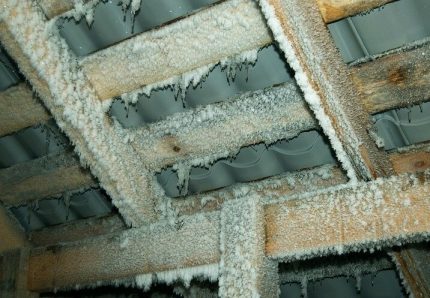
The consequences of this phenomenon are the most unpleasant and destructive:
- Wet wooden structures are affected by the fungus and gradually collapse;
- Metal fasteners begin to rust and lose strength;
- Condensate dripping from the roof structures onto the floor or attic insulation penetrates into it, negating the thermal insulation properties.
The second common form of negative consequences from improper installation of the ridge plate or ridge aerator, or the lack of a seal in them is the ingress of foreign objects into the roof structure.
In windy weather, rain or snow can penetrate into the under-roof space, leading to wetting of the elements of the roof or insulation.
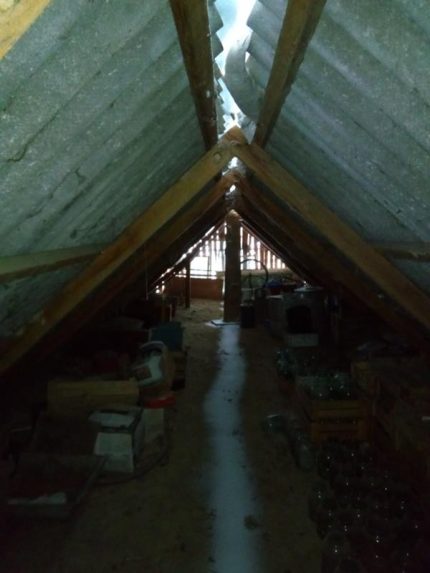
If there is no ridge seal or tape, birds can enter the attic. They can make nests there and annoy with constant noise, and they can pick and pull out a heater for the construction of their nests.

Another dangerous consequence of the lack of ridge ventilation can be the formation of an ice dam (congestion) on the roof. Such a phenomenon is inherent in poorly insulated roofs with a slight slope, which retains snow on themselves, or in the presence of snow retainers installed on the eaves.
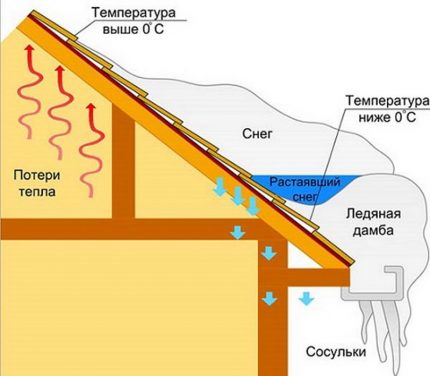
This phenomenon is especially dangerous if people walk under the eaves, because falling icicles and ice can cause irreparable harm.
It should also be noted that ridge ventilation is only an integral element in the ventilation of the roof and attic and, in fact, is a hood. Based on this, for its normal operation it is required to provide an air flow under the roof, for example, through eaves.
If this is neglected, then in the absence of the necessary inflow of air, even ideally made ridge ventilation, there will simply be nothing to pull it into the street, and water vapor will continue to accumulate in the roof structure and destroy it.
In addition, arranging the ridge ventilation, we must not forget about the installation of vapor barrier floors and attic slopes, they will protect the insulated structures from domestic fumes. In cold roofs, steam barriers are not used. To protect both atmospheric and cold roofs from atmospheric water, waterproofing is necessary.
Also a mandatory component of roof ventilation are dormer and pediment windows. The first are built on hip and tent types of roofs, the second - on single-pitched, gable and broken. In addition to them, as an addition, they are mounted vent valves with and without fans, vents and other devices.
Conclusions and useful video on the topic
The video shows how to independently make a ventilated ridge on the roof of flexible tiles:
Video of installing a ridge with a seal on a metal tile:
Mounting a ridge aerator with a deflector:
Installation of a deaf ridge and ridge aerator on a roof made of flexible tiles:
Video about the causes of condensation in the attic and the need for ventilation:
Ridge ventilation is an important element to extend the life of roof structures. Moreover, thanks to various design options and a wide selection of finished products, it is possible to make or install ventilation yourself.
The main thing is to choose the right type of ridge ventilation specifically for your roof.
Please write comments in the form below the block. Tell us about how your roof is ventilated through the ridge.It is possible that your recommendations and the information you provide will be very useful to site visitors.

 Roof ventilation from a profiled sheet: recommendations for design and installation
Roof ventilation from a profiled sheet: recommendations for design and installation  Ventilation pipes for the roof: tips for choosing a pipeline + installation instruction
Ventilation pipes for the roof: tips for choosing a pipeline + installation instruction 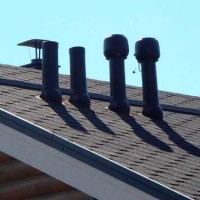 Adjoining the roof to the ventilation shaft: arrangement of the passage of the ventilation unit through the roof
Adjoining the roof to the ventilation shaft: arrangement of the passage of the ventilation unit through the roof  How to hang a hood over a gas stove: step-by-step installation guide
How to hang a hood over a gas stove: step-by-step installation guide 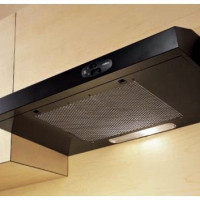 Installing the built-in hood: location options and installation instructions
Installing the built-in hood: location options and installation instructions 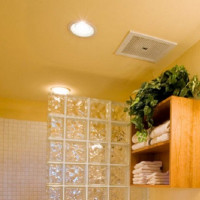 Ventilation in the bathroom in the ceiling: arrangement features + installation instructions for the fan
Ventilation in the bathroom in the ceiling: arrangement features + installation instructions for the fan  How much does it cost to connect gas to a private house: the price of organizing gas supply
How much does it cost to connect gas to a private house: the price of organizing gas supply  The best washing machines with dryer: model rating and customer tips
The best washing machines with dryer: model rating and customer tips  What is the color temperature of light and the nuances of choosing the temperature of the lamps to suit your needs
What is the color temperature of light and the nuances of choosing the temperature of the lamps to suit your needs  Replacement of a geyser in an apartment: replacement paperwork + basic norms and requirements
Replacement of a geyser in an apartment: replacement paperwork + basic norms and requirements